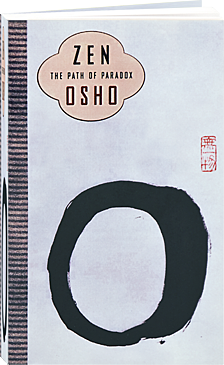Zen: The Path of Paradox

Zen: The Path of Paradox
Selected Chapters from the Original 3-Volume Classic
Book
A perfect introduction to the paradoxical world of Zen, and a companion text to the Meditations on Zen audiobook published by Audio Renaissance and also available for download in MP3 format on www.audible.com. In these commentaries on Zen anecdotes and stories, Osho leads the reader step by step through the mystery of the words into a deeper understanding of this unique approach to life. Concluding with a chapter of responses to questions, the text of the book has been selected from a series of talks originally called "Zen: The Path of Paradox." Introducing the book, Osho says: "Zen lives in the present. The whole teaching is how to be in the present - how to get out of the past, which is no more, and how not to get involved in the future which is not yet. And just to be rooted, centered, in that which is."
Chapter Titles
#1: Empty Sky
#2: Much Zen
#3: The Governor of Kyoto
#4: The Man on the Hill
#5: A Good Swift Kick
#6: The Path of Paradox
Responses to Questions
Details
In these commentaries on Zen anecdotes and stories, Osho leads the reader step by step through the mystery of the words into a deeper understanding of this unique approach to life.
Excerpt from: Zen: The Path of Paradox, the Foreword
"Zen goes beyond Buddha and beyond Lao Tzu. It is a culmination, a transcendence, both of the Indian genius and of the Chinese genius. The Indian genius reached its highest peak in Gautam the Buddha and the Chinese genius reached its highest peak in Lao Tzu. And the meeting…the essence of Buddha’s teaching and the essence of Lao Tzu’s teaching merged into one stream so deeply that no separation is possible now. Even to make a distinction between what belongs to Buddha and what to Lao Tzu is impossible, the merger has been so total. It is not only a synthesis, it is an integration. Out of this meeting Zen was born. Zen is neither Buddhist nor Taoist and yet both.
To call Zen "Zen Buddhism"is not right because it is far more. Buddha is not so earthly as Zen is. Lao Tzu is tremendously earthly, but Zen is not only earthly: its vision transforms the earth into heaven. Lao Tzu is earthly, Buddha is unearthly, Zen is both – and in being both it has become the most extraordinary phenomenon.
"The future of humanity will go closer and closer to the approach of Zen, because the meeting of the East and West is possible only through something like Zen, which is earthly and yet unearthly. The West is very earthly, the East is very unearthly. Who is going to become the bridge? Buddha cannot be the bridge; he is so essentially Eastern, the very flavor of the East, the very fragrance of the East, uncompromising. Lao Tzu cannot be the bridge; he is too earthly. China has always been very earthly. China is more part of the Western psyche than of the Eastern psyche.
"It is not an accident that China is the first country in the East to turn communist, to become materialist, to believe in a godless philosophy, to believe that man is only matter and nothing else. This is not just accidental. China has been earthly for almost five thousand years; it is very Western. Hence Lao Tzu cannot become the bridge; he is more like Zorba the Greek. Buddha is so unearthly you cannot even catch hold of him – how can he become the bridge?
"When I look all around, Zen seems to be the only possibility, because in Zen, Buddha and Lao Tzu have become one. The meeting has already happened. The seed is there, the seed of that great bridge which can make East and West one. Zen is going to be the meeting-point. It has a great future – a great past and a great future.
"And the miracle is that Zen is neither interested in the past nor in the future. Its total interest is in the present. Maybe that’s why the miracle is possible, because the past and the future are bridged by the present.
"The present is not part of time. Have you ever thought about it? How long is the present? The past has a duration, the future has a duration. What is the duration of the present? How long does it last? Between the past and the future can you measure the present? It is immeasurable; it is almost not. It is not time at all: it is the penetration of eternity into time.
"And Zen lives in the present. The whole teaching is: how to be in the present, how to get out of the past which is no more and how not to get involved in the future which is not yet, and just to be rooted, centered, in that which is the whole approach of Zen is of immediacy, but because of that it can bridge the past and the future. It can bridge many things: it can bridge the past and the future, it can bridge the East and the West, it can bridge body and soul. It can bridge the unbridgeable worlds: this world and that, the mundane and the sacred." Osho
Details
More Information
Type Abridged Product
Publisher St. Martins Press, USA
ISBN-13 312320493
Dimensions (size) 138 x 210 mm
Number of Pages 192
- Log in to post comments
- 46 views
